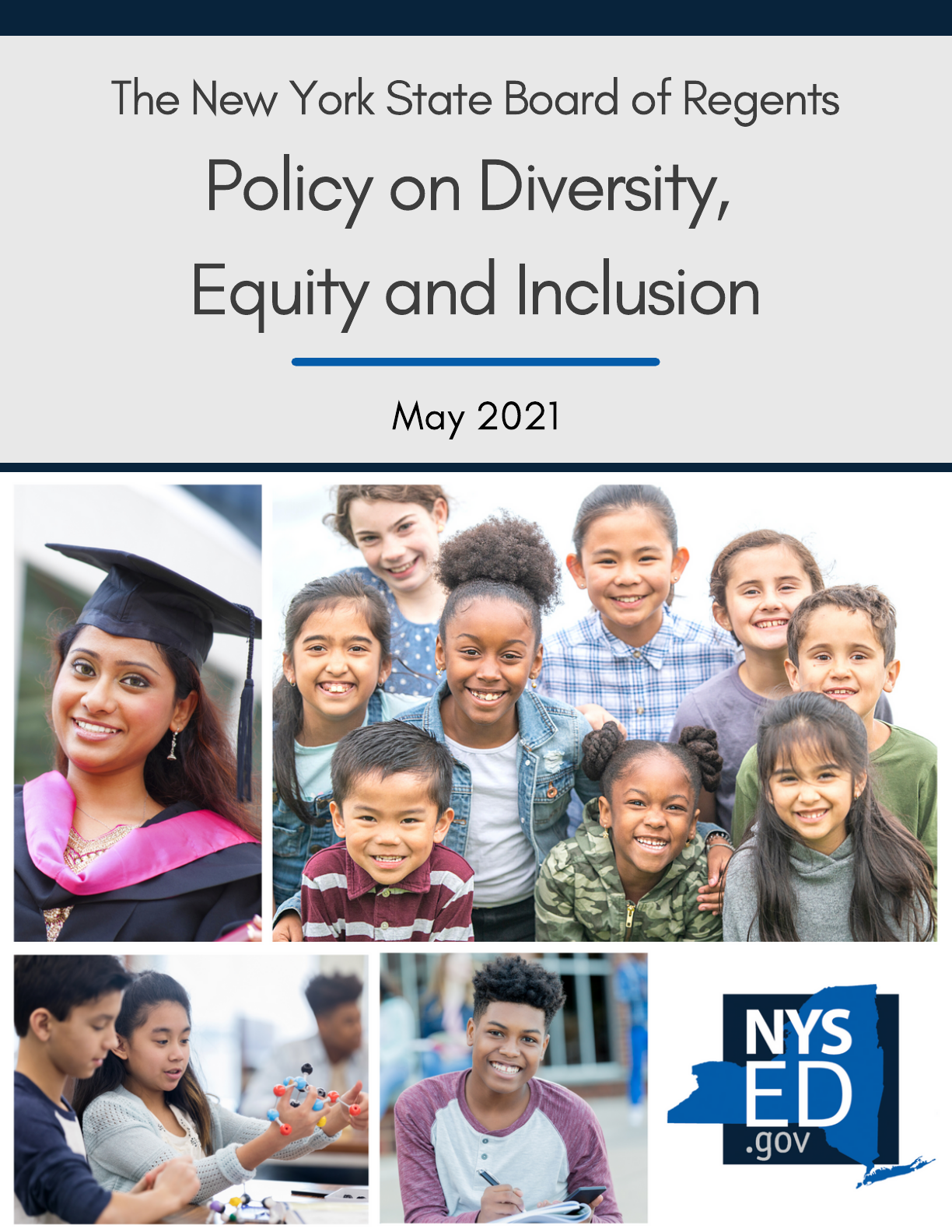
THE STATE EDUCATION DEPARTMENT / THE UNIVERSITY OF THE STATE OF NEW YORK / ALBANY, NY 12234
TO: The Honorable the Members of the Board of Regents
FROM: Chancellor Lester W. Young, Jr.
SUBJECT: The New York State Board of Regents Policy Statement
on Diversity, Equity and Inclusion in New York State
Schools
DATE: May 6, 2021
AUTHORIZATION(S):
SUMMARY
Issue for Action
At the Board of Regents meeting in April 2021, the Board discussed a framework
on Diversity, Equity and Inclusion for New York State Schools which served as the basis
for adopting a policy statement. At the May 2021 meeting of the Board, they will
discuss and act on the proposed policy statement. The policy of the NYS Board of
Regents is to encourage and support efforts at the State and local level to create within
every school an ecosystem of success that is built upon a foundation of diversity,
equity, inclusion, access, opportunity, innovation, confidence, trust, respect, caring,
and relationship-building. All students must feel that they are welcome, they
belong, and they are supported in every school.
The Board of Regents recognizes that much of this work is already happening in
districts all across the State. School and district leaders, teachers, staff, students, and
parents are working to create school communities that are more diverse, more equitable,
and more inclusive than ever before. Many of New York’s education stakeholders and
their organizations have prioritized this issue, and their efforts must be recognized and
applauded. But more work remains, and the Board of Regents and the State Education
Department are committed to supporting schools and districts in their efforts to lift up all
students.
Reason(s) for Consideration
For action.
BR (A) 7

Proposed Handling
The policy statement will come before the Full Board for decision at the May
2021 meeting.
Related Regent’s Items
April 2021: The NYS Board of Regents Framework on Diversity, Equity, and
Inclusion in New York’s Schools: A Call to Action - DRAFT
(https://www.regents.nysed.gov/common/regents/files/421brd1.pdf)
Recommendation
It is recommended that the Board of Regents approve the policy statement that will
advance diversity, equity and inclusion in New York schools.
VOTED, that The New York State Board of Regents Policy Statement on Diversity,
Equity and Inclusion in New York Schools be approved.
Timetable for Implementation
Effective May 10, 2021.

THE UNIVERSITY OF THE STATE OF NEW YORK
Regents of The University
LESTER W. YOUNG, JR., Chancellor, B.S., M.S., Ed.D. ....................................... Beechhurst
ROGER TILLES, B.A., J.D. .................................................................................... Manhasset
CHRISTINE D. CEA, B.A., M.A., Ph.D. ............................................................... Staten Island
WADE S. NORWOOD, B.A. .................................................................................. Rochester
KATHLEEN M. CASHIN, B.S., M.S., Ed.D. ......................................................... Brooklyn
JAMES E. COTTRELL, B.S., M.D. .......................................................................... New York
JOSEPHINE VICTORIA FINN, B.A., J.D. ............................................................... Monticello
JUDITH CHIN, B.S., M.S. in Ed. .......................................................................... Little Neck
BEVERLY L. OUDERKIRK, B.S. in Ed., M.S. in Ed. ............................................. Morristown
CATHERINE COLLINS, R.N., N.P., B.S., M.S. in Ed., Ed.D. .............................. Buffalo
NAN EILEEN MEAD, B.A., M.A. ......................................................................... Manhattan
ELIZABETH S. HAKANSON, A.S., B.A., M.A., C.A.S. ........................................ Syracuse
LUIS O. REYES, B.A., M.A., Ph.D. ...................................................................... New York
SUSAN W. MITTLER, B.S., M.S. ........................................................................... Ithaca
FRANCES G. WILLS, B.A., M.A., M.Ed., C.A.S., Ph.D. ...................................... Ossining
RUTH B. TURNER, BSW, LCSW, M.Ed. .............................................................. Rochester
ARAMINA VEGA FERRER, B.A., M.S. in Ed., Ph.D. ........................................... Bronx
Commissioner of Education and President of The University
BETTY A. ROSA, B.A., M.S. in Ed., M.S. in Ed., M.Ed., Ed.D.
The State Education Department does not discriminate on the basis of race, creed, color, national origin,
religion, age, sex, military, marital status, familial status, domestic violence victim status, carrier status,
disability, genetic predisposition, sexual orientation and criminal record in its recruitment, educational
programs, services, and activities. NYSED has adopted a web accessibility policy, and publications
designed for distribution can be made available in an accessible format upon request. Inquiries regarding
this policy of nondiscrimination should be directed to the Office of Human Resources Management,
Room 528 EB, Education Building, Albany, New York 12234.
1
The New York State Board of Regents Policy Statement on
Div
ersity, Equity and Inclusion in New York State Schools
The New York State Constitution authorizes the Board of Regents to oversee the general
supervision of all educational activities within the State. The Regents exercise their
authority in various ways, including by promulgating rules and regulations, adopting
student learning standards, establishing academic and graduation requirements, and
providing guidance and best practices to the field to ensure academic excellence for all
students. The Board may also exercise its authority by adopting policy positions on
significant educational and social issues. It is important for the Board of Regents to
establish and communicate to all New Yorkers its beliefs and expectations for all schools
and students – especially at those pivotal moments in history that we are currently
experiencing.
A growing body of research finds that all students benefit when their schools implement
strong Diversity, Equity and Inclusion (DEI) policies and practices – including academic,
cognitive, civic, social-emotional, and economic benefits. Strong DEI policies, in
partnership with parents and families, empower students from all backgrounds to
visualize successful futures for themselves and provide them with a sense of belonging
and self-worth. These benefits can lead to improved student achievement, which in turn
can lead to better outcomes in other areas of their lives, including work and civic
engagement. This is true regardless of a school’s geographic location or the demographic
composition of its students and faculty.
We recognize that the decision to adopt a DEI policy, as well as the contents of such a
policy, are ultimately matters of local discretion. However, the Regents believe strongly
that there is a moral and an economic imperative to remove the inequities that stand in
the way of success for whole segments of New York’s student population. Accordingly,
the Board expects that all school districts and institutions of higher education will develop
and implement policies and practices that advance diversity, equity and inclusion – and
that they will implement such policies and practices with fidelity and urgency.
It shall therefore be the policy of the NYS Board of Regents to encourage and support
efforts at the State and local level to create within every school an ecosystem of success
that is built upon a foundation of diversity, equity, inclusion, access, opportunity,
innovation, confidence, trust, respect, caring, and relationship-building. All students
must feel that they are welcome, they belong, and they are supported in every school.
The Board of Regents believes that effective DEI policies must consider the entirety of
the schooling process and expects districts to include the following elements in their
policies:
• Governance: Establish a district Diversity, Equity and Inclusion Committee that
is representative of all stakeholders, including students.

2
• Teaching and Learning: Address the need for inclusive and culturally
responsive teaching and learning, including but not limited to curricula in all
content areas; books and instructional materials; pedagogical practices and
professional development; classroom grouping policies and practices; student
support systems for all developmental pathways; full and equitable opportunities
to learn for all students; and multiple assessment measures.
As part of this work, districts should consider:
o Specifically acknowledging the role that racism and bigotry have played,
and continue to play, in the American story.
o Adopting a Culturally Responsive-Sustaining (CR-S) Framework that
specifically embeds the ideals of diversity, equity and inclusion by creating
student-centered learning environments that affirm cultural identities; foster
positive academic outcomes; develop students’ abilities to connect across
lines of difference; elevate historically marginalized voices; empower
students as agents of social change; and contribute to individual student
engagement, learning, growth, and achievement through the cultivation of
critical thinking.
o Actively avoiding the “danger of the single story.” When one story is the only
story, it becomes the definitive story; when that happens in school, students
are deprived of the opportunity of seeing themselves as part of the
American story. This is not about eliminating or minimizing any of America’s
history; it is simply about ensuring that the contributions of all groups are
included in the telling of the American story.
o Ensuring coherent opportunities for students to actively participate in
experiences that prepare them for a lifetime of civic engagement and
contributions to social justice, including, for example, completing projects
that enable students to apply the learning they have acquired within and
across subject areas.
• Family and Community Engagement: Ensure that family and community
engagement practices are based on mutual trust, confidence, and respect.
Encourage participation in community building conversations, reducing language
barriers, and fostering inclusivity through translated communications from our
schools.
• Workforce Diversity: Recruit and retain a diverse workforce in all areas and at
all levels, thereby reducing stereotypes and preparing students for an
increasingly global society.
3
• Diverse Schools and Learning Opportunities: Districts should –
o Take creative steps to enhance the level of socioeconomic and racial
diversity within district schools (even if the district’s student population is
relatively homogeneous).
o Examine the use of language which prevents some students from accessing
and fully participating in the district’s classes, programs, and offerings.
Language matters, and it is therefore critical that districts eliminate the use
of terms and phrases that perpetuate negative stereotypes and minimize
student opportunities.
o Ensure that coursework, programs, and activities are accessible to all
students, regardless of their disability status, native language, income level,
or any other basis.
• Student Supports, Discipline, and Wellness: Districts should –
o Employ programs and practices that enhance all students’ self-identity, self-
confidence, and self-esteem.
o Implement non-discriminatory discipline policies and practices.
o Focus on the well-being of the “whole child” by always considering and
addressing the full range of student developmental pathways.
The Board of Regents acknowledges that much of this work is already happening in
districts all across the State. School and district leaders, teachers, staff, students, and
parents are working to create school communities that are more diverse, more equitable,
and more inclusive than ever before. Many of New York’s education stakeholders and
their organizations have prioritized this issue, and their efforts must be recognized and
applauded. But more work remains, and the Board of Regents and the State Education
Department are committed to supporting schools and districts in their efforts to lift up all
students.
